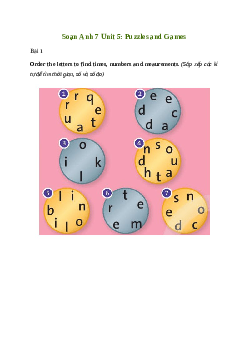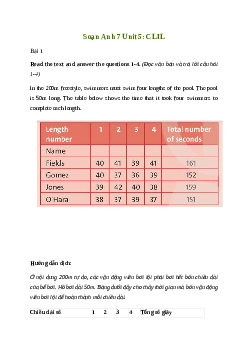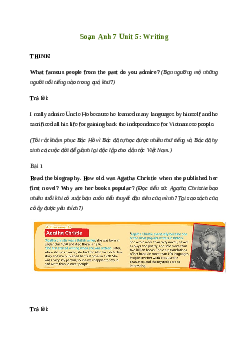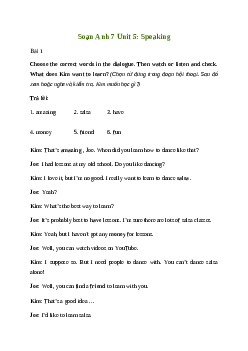





Preview text:
Soạn Anh 7 Unit 5: Language Focus 2 Bài 1
Change the words in bold from affirmative to negative, or negative to
affirmative, to make sentences. (Chuyển các từ in đậm từ khẳng định sang phủ
định hoặc phủ định thành khẳng định để đặt câu.)
1. Most children can read until they're six.
2. Mozart couldn't compose music when he was five. Trả lời:
1. Most children cannot read until they're six.
2. Mozart could compose music when he was five. Hướng dẫn dịch:
1. Hầu hết trẻ em không thể đọc cho đến khi lên sáu.
2. Mozart có thể sáng tác nhạc khi mới 5 tuổi. Bài 2
Look at the sentences in exercise 1 again and choose the correct words in
the Rules. (Nhìn lại các câu trong bài tập 1 và chọn từ đúng trong Quy tắc.) Trả lời: 1. present – past 2. without 3. can 4. can’t and couldn’t 5. don’t use Hướng dẫn dịch:
1. Ta dùng ‘can’ để nói về hiện tại và ‘could’ để nói về quá khứ.
2. Ta dùng dạng nguyên thể không ‘to’ sau ‘can’ và ‘could’.
3. Dạng he/she/it của ‘can’ là ‘can’.
4. Dạng phủ định là ‘can’t’ và ‘couldn’t’.
5. Ta không dùng ‘do’ và ‘did’ để tạo câu hỏi với ‘can’ và ‘could’. Bài 3
Look at the sentences in exercise 1 again and choose the correct words in
the Rules. (Nhìn lại các câu trong bài tập 1 và chọn từ đúng trong Quy tắc.)
William Sidis - Supergenius
Most people can't read until they're six and they (1) usually speak one, two or
maybe three languages as children.
William Sidis was born in 1898, and when he was eighteen months old, he (2)
read. Before he was eight he wrote four books and (3) speak eight languages.
William was a genius with a very high IQ, but in the end he lived a lonely life.
He went to university at eleven, but he (4) make friends and was very unhappy.
William died in 1944. Prodigies (5) do special or amazing things, but they (6)
always find a place in society. Life is sometimes difficult when you're different. Trả lời: 1. can’t 2. can 3. could 4. couldn’t 5. can 6. can’t Hướng dẫn dịch:
Hầu hết mọi người không thể đọc cho đến khi lên sáu và họ thường không thể
nói một, hai hoặc có thể ba ngôn ngữ khi còn nhỏ.
William Sidis sinh năm 1898, khi mới mười tám tháng tuổi, anh đã biết đọc.
Trước khi lên tám, ông đã viết bốn cuốn sách và có thể nói tám thứ tiếng.
William là một thiên tài với chỉ số IQ rất cao, nhưng cuối cùng anh lại sống một
cuộc đời cô đơn. Anh ấy học đại học năm mười một tuổi, nhưng anh ấy không
thể kết bạn và rất bất hạnh. William mất năm 1944. Thần đồng có thể làm
những điều đặc biệt hoặc đáng kinh ngạc, nhưng không phải lúc nào họ cũng có
thể tìm được chỗ đứng trong xã hội. Cuộc sống đôi khi khó khăn khi bạn khác biệt. Bài 4
Match 1-6 with a-f to make questions. Can you remember the answers?
Ask and answer the questions with your partner. (Ghép 1-6 với a-f để đặt
câu hỏi. Bạn có thể nhớ câu trả lời? Hỏi và trả lời các câu hỏi với đối tác của bạn.) Trả lời: 1. b 2. f 3. e 4. a 5. c 6. d Hướng dẫn dịch:
1. Chuối chứa bao nhiêu kali?
2. Carl Lewis có thể chạy nhanh đến mức nào?
3. Mount Eyerest cao bao nhiêu?
4. Người tập thể hình nên ăn trứng bao lâu mỗi ngày?
5. Twista có thể rap bao nhiêu từ trong một phút?
6. William Sids bắt đầu đọc bao nhiêu tuổi? Bài 5
Make questions with “How” and the words in the table. Then ask and
answer the questions with your partner. (Đặt câu hỏi với "Làm thế nào" và
các từ trong bảng. Sau đó hỏi và trả lời các câu hỏi với đối tác của bạn.) Trả lời: 1. How high can you jump?
2. How far can you run and swim?
3. How many words can you say in ten seconds? 4. How strict is your teacher? 5. How tall are you?
6. How often are you late for school?
7. How cold/ hot is your town in winter?
8. How much does a burger cost?
9. How long can you keep your eyees open? Hướng dẫn dịch:
1. Bạn có thể nhảy cao đến mức nào?
2. Bạn có thể chạy và bơi bao xa?
3. Bạn có thể nói bao nhiêu từ trong mười giây?
4. Giáo viên của bạn nghiêm khắc như thế nào?
5. Bạn cao bao nhiêu?
6. Bạn thường xuyên đi học muộn không?
7. Thị trấn của bạn lạnh / nóng như thế nào vào mùa đông?
8. Một chiếc bánh mì kẹp thịt giá bao nhiêu?
9. Bạn có thể mở mắt trong bao lâu?
Document Outline
- Soạn Anh 7 Unit 5: Language Focus 2
- Bài 1
- Bài 2
- Bài 3
- Bài 4
- Bài 5



